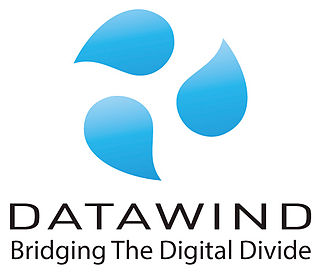Mobile blogging (also known as moblogging [1] ) is a method of publishing to a website or blog from a mobile phone or other handheld device. A moblog helps habitual bloggers to post write-ups directly from their phones even when on the move. [2] Mobile blogging has been made possible by technological convergence, as bloggers have been able to write, record and upload different media all from a single, mobile device. At the height of its growth in 2006, mobile blogging experienced 70,000 blog creations a day and 29,100 blog posts an hour. [3] Between 2006 and 2010, blogging among teens declined from 28% to 14%, while blogging among adults over 30 increased from 7% to 11%. [4] However, the growing number of multi-platform blogging apps has increased mobile blogging popularity in recent years creating a brand new market that many celebrities, regular bloggers and specialists are utilizing to widen their social reach. [5]
Mobile blogging is popular among people with camera phones which allow them to e-mail/MMS or SMS photos and video that then appear as entries on a web site, or to use mobile browsers to publish content directly to any blogging platform with Mobile Posting compatibility. [6] [7] As the ability of camera phone users to publish their own blogs has increased, so too has the ability for collective submissions. Users are now able to access the posts of other bloggers in the immediate area through a process called Georeferential Blogging; which utilizes geographical location to collectively group blogging activity. [8] This advancement unites the posts of local bloggers in an effort to increase the relevancy of information to those in the area.
One of the precursors to a "moblog" was the development of a wearable photographic device by Steve Mann of the University of Toronto. Termed "domewear," the intention was for human rights workers to wear the devices to take photographic and video evidence of dangerous situations while avoiding being targeted for using traditional cameras. [9] The first recorded example of moblogging was on 1995 February 22, when Steve Mann posted text from his wearable mobile computer to his weblog server, together with video (image sequence). [10] The term moblogging, however, wasn't coined until 2002, by Adam Greenfield. [1] Mobile devices have expanded beyond basic communication and now these devices can support multimedia creation tools. [11]
The mobile blogging system has its origins in a technology-inspired design approach. This approach incorporates the rich feature set of a smartphone, including the ability to create multimedia, capturing decent images, and connectivity options. The intersection between the inherent design functions of the phone with the ongoing, personal nature of both a phone and a blog is how the concept of mobile blogging began. In the case study of SmartBlog, a system created to support mobile blogging, key principles were developed after assessing bloggers' needs. [11] These include:
The client, in this instance, refers to a Thin client. [11]
A moblog platform offers the capability to use a phone for administration, editing and writing from a phone or smartphone browser. There are services and platforms which present different versions of a blog administration interface based on user agent.
Mobile blogging also promotes the dissemination of ideas and perspectives of younger people, who previously have not had as many easily accessible platforms to present their views. [12]
The continued integration of Mobile Blogging into areas of education has revealed many of its advantages. Its benefits affect both students and teachers, and have improved the overall educational experience. For students, it allows them to stay up-to-date with class schedules, access materials, and it inspires a more creative dimension with the inclusion of visual and audible materials in their work environment. [13]
For teachers, mobile blogging has allowed further monitoring of students’ progress and participation. [13]
Mobile blogging can be used alongside computer-supported collaborative learning in the classroom. This provides a positive and encouraging learning environment for students, especially students in a virtual classroom. Working collaboratively with mobile blogging can provide more authentic context learning and can help solve the coordination issue that often arises from working in a collaborative learning environment. [14]
Mobile blogging is particularly helpful to tourists and travelers when access to a computer with Internet connection may be difficult. The traveller can snap photos and with a GPRS or a WAP-enabled phone can easily upload such pictures with text descriptions directly to his or her blog. If the camera phone is equipped for Autogeotagging, the blog may be able to show a map of the locations.
One of the most significant challenges to mobile blogging is lack of access to both mobile devices and internet connections. While mobile blogging encourages production and spread of information to seemingly limitless people, it must be understood in regards to the advantages and disadvantages of socioeconomic status and geographical location. [12]
One of the most substantial and relevant challenges to having a mobile blogging network is the costs involved. Western countries face relatively cheap costs in terms of data plans and expenditures related to mobile devices, yet in most places around the world, these costs are very substantial and restrictive. When the costs are too high, mobile blogging and its benefits become irrelevant. [13]

A blog is an informational website published on the World Wide Web consisting of discrete, often informal diary-style text entries (posts). Posts are typically displayed in reverse chronological order so that the most recent post appears first, at the top of the web page. Until 2009, blogs were usually the work of a single individual, occasionally of a small group, and often covered a single subject or topic. In the 2010s, "multi-author blogs" (MABs) emerged, featuring the writing of multiple authors and sometimes professionally edited. MABs from newspapers, other media outlets, universities, think tanks, advocacy groups, and similar institutions account for an increasing quantity of blog traffic. The rise of Twitter and other "microblogging" systems helps integrate MABs and single-author blogs into the news media. Blog can also be used as a verb, meaning to maintain or add content to a blog.

A smartphone is a portable computer device that combines mobile telephone functions and computing functions into one unit. They are distinguished from older-design feature phones by their more advanced hardware capabilities and extensive mobile operating systems, which facilitate wider software, access to the internet, and multimedia functionality, alongside core phone functions such as voice calls and text messaging. Smartphones typically contain a number of metal–oxide–semiconductor (MOS) integrated circuit (IC) chips, include various sensors that can be leveraged by pre-installed and third-party software, and support wireless communication protocols. More recently, smartphone manufacturers have begun to integrate satellite messaging connectivity and satellite emergency services into devices for use in remote regions where there is no reliable cellular network.

A mobile device is a computer, small enough to hold and operate in the hand. Mobile devices typically have a flat LCD or OLED screen, a touchscreen interface, and digital or physical buttons. They may also have a physical keyboard. Many such devices can connect to the Internet and connect with other devices such as car entertainment systems or headsets via Wi-Fi, Bluetooth, cellular networks or near field communication. Integrated cameras, the ability to place and receive voice and video telephone calls, video games, and Global Positioning System (GPS) capabilities are common. Power is typically provided by a lithium-ion battery. Mobile devices may run mobile operating systems that allow third-party applications to be installed and run.
Windows Mobile was a family of mobile operating systems developed by Microsoft for smartphones and personal digital assistants.

A vlog, also known as a video blog or video log, is a form of blog for which the medium is video. Vlog entries often combine embedded video with supporting text, images, and other metadata. Entries can be recorded in one take or cut into multiple parts. Vlog category is popular on the video-sharing platform YouTube.
M-learning, or mobile learning, is a form of distance education where learners use portable devices such as mobile phones to learn anywhere and anytime. The portability that mobile devices provide allows for learning anywhere, hence the term "mobile" in "mobile learning." M-learning devices include computers, MP3 players, mobile phones, and tablets. M-learning can be an important part of informal learning.
This is a list of blogging terms. Blogging, like any hobby, has developed something of a specialized vocabulary. The following is an attempt to explain a few of the more common phrases and words, including etymologies when not obvious.

A photoblog is a form of photo sharing and publishing in the format of a blog. It differs from a blog through the predominant use of and focus on photographs rather than text. Photoblogging gained momentum in the early 2000s with the advent of the moblog and cameraphones.

The mobile web refers to mobile browser-based World Wide Web services accessed from handheld mobile devices, such as smartphones or feature phones, through a mobile or other wireless network.
Mobile VoIP or simply mVoIP is an extension of mobility to a voice over IP network. Two types of communication are generally supported: cordless telephones using DECT or PCS protocols for short range or campus communications where all base stations are linked into the same LAN, and wider area communications using 3G or 4G protocols.
An edublog is a blog created for educational purposes. Edublogs archive and support student and teacher learning by facilitating reflection, questioning by self and others, collaboration and by providing contexts for engaging in higher-order thinking. Edublogs proliferated when blogging architecture became more simplified and teachers perceived the instructional potential of blogs as an online resource. The use of blogs has become popular in education institutions including public schools and colleges. Blogs can be useful tools for sharing information and tips among co-workers, providing information for students, or keeping in contact with parents. Common examples include blogs written by or for teachers, blogs maintained for the purpose of classroom instruction, or blogs written about educational policy. Educators who blog are sometimes called edubloggers.
The Nokia 7650 is a 2.5G consumer-oriented smartphone belonging to the fashion and experimental (7xxx) series. It was introduced in Barcelona on 19 November 2001, and was described by CEO Jorma Ollila as the company's most important launch of that year.
Mobile-assisted language learning (MALL) is language learning that is assisted or enhanced through the use of a handheld mobile device.
A Mobile Web Server is software designed for modern-day smartphones to host personal web servers, through the use of open sourced software, such as, i-jetty, an open source software, based on jetty. I-jetty is an open source web container, serving Java-based web content such as, servlets and JSPs. Jetty is written in Java and its API is available as a set of JARs. Developers can instantiate a jetty container as an object, instantly adding network and web connectivity to a stand-alone Java app. Jetty is built for scalable performance allowing tens of thousands of HTTP connections and hundreds of thousands of simultaneous web socket connections. Jetty is optimized and known for creating small memory footprints, increasing scalability and performance.
Novarra was a mobile internet software company founded in 2000 and based in Itasca, Illinois, United States. It created web-based services such as web internet access, portals, videos, widgets and advertising for mobile devices. Novarra provided access to the internet and other services through wireless handsets, PDAs and laptops and sold directly to operators, mobile handset manufacturers and internet brand companies. In 2010, Nokia acquired 100% of Novarra's shares.

The Samsung Omnia II GT-I8000(H/L/U) is a multimedia smartphone announced at Samsung Mobile Unpacked on June 15, 2009. Earlier Omnia II releases run Windows Mobile 6.1, however they are upgradable to version 6.5 Professional. There is also an unofficial and experimental Android version available. Verizon is the official US carrier for this phone and released it in December 2009.

Mobile technology is the technology used for cellular communication. Mobile technology has evolved rapidly over the past few years. Since the start of this millennium, a standard mobile device has gone from being no more than a simple two-way pager to being a mobile phone, GPS navigation device, an embedded web browser and instant messaging client, and a handheld gaming console. Many experts believe that the future of computer technology rests in mobile computing with wireless networking. Mobile computing by way of tablet computers is becoming more popular. Tablets are available on the 3G and 4G networks. Mobile technology has different meanings in different aspects, mainly mobile technology in information technology and mobile technology in basketball technology, mainly based on the wireless technology of wireless devices equipment information technology integration.

Jeotex, Inc., known as Datawind, Inc until 2019. and founded in Montreal, Quebec, Canada, is a developer and manufacturer of low-cost tablet computers and smartphones. Datawind manufactures low cost tablets and sells these primarily in India, Nigeria, the United Kingdom, Canada, and the United States. The company is known for its development of the Aakash tablet computer, which is the “world's cheapest tablet” at US$37.99/unit. The Aakash tablet was developed for India's Ministry for Human Resource Development (MHRD).

ChatON was a global mobile communication service introduced by Samsung Electronics in September 2011. ChatON served more than 120 countries in 62 languages. ChatON was available on Android, iOS, BlackBerry, Windows Phone, Windows Mobile (Korea), and Bada smartphones. Additionally, a web client was offered for access to the service via web browsers. Users could invite and register buddies via Facebook and Twitter as well as share ChatON content on Facebook. Among ChatON's unique features were allowing users to create Animation messages, Broadcast to send personal notices in a group chat room, and the Trunk which stores media files shared in chats. When a user logs in ChatON, the user's buddy list is available on any connected device.

Ubuntu Touch is a mobile version of the Ubuntu operating system, being developed by the UBports community. Its user interface is written in Qt, and is designed primarily for touchscreen mobile devices such as smartphones and tablet computers, but the original goal of convergence was intended to bring Ubuntu Touch to laptops, desktops, IOT devices and TVs for a complete unified user experience.